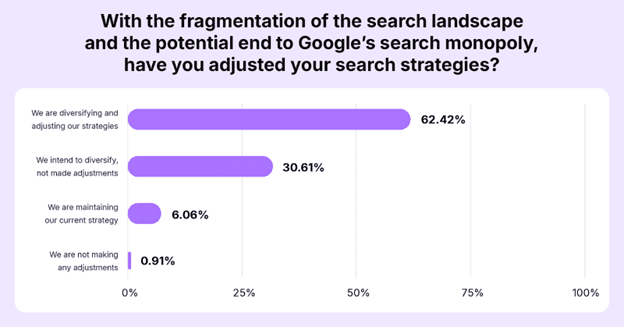The emergence of AI-powered platforms has ignited a profound shift in how we interact with technology and the trajectory of the search landscape. While Google remains the dominant driver of organic website traffic for retailers, AI-powered platforms — ChatGPT, Perplexity AI, Microsoft Copilot, Meta AI, ByteDance and others — are claiming their stake and increasing bot traffic to websites. The reality is that these platforms, bots and AI agents already are visiting websites to complete tasks like booking travel or performing research.
The expanded landscape and anticipated bot-driven website traffic are ushering in the future of search, and both retailers and marketers must prepare to reimagine their organic search strategies and ensure they can show up when and where consumers are searching.
Consumer Behavior is Changing…Intent is Not
For two decades, Google has shaped the way we search. We’ve come to expect brands to meet us where we are with the products and answers we want. This new age in search means that consumers will have to expend less effort to get what they need, with AI doing the legwork to explore site content, evaluate information and make product recommendations. Consumer expectations will only grow, and brands will need to adapt and be found across new search environments if they want to stay visible.
While consumer intent remains the same for purchasing products like running shoes, car seats and backyard grills, identifying a need and making a purchase decision has changed thanks to the advent of tools like ChatGPT. Using AI search platforms is akin to having personal shoppers who provide tailored, contextually relevant answers instead of a long list of links to surf. Leveraging AI search allows consumers to discover brands and products directly through conversation with an AI assistant, often without clicking a single link. Now, the customer journey from brand discovery to research to conversion is accomplished by AI.
Advertisement
Where legacy search engines function more as intermediaries, AI search engines can build on questions and conversations, recall previous interactions and improve over time to deliver better responses. For retail and ecommerce, the search evolution transforms the journey from a series of clicks to more meaningful engagements. Brands may see human traffic decrease and bot traffic increase with each interaction of higher quality and aligned more closely to intent.
AI and the Purchase Cycle
Although brick-and-mortar, in-store visits account for 80% of all shopping, the online marketplace is increasingly becoming the new norm, reinforcing the importance of online search strategies to meet and engage consumers. Today, nearly half (47%) of consumers report feeling most comfortable using AI in the discovery phase of purchase decisions, and retailers must understand how to show up across the purchasing cycle.
Like many innovations building upon prior ones, AI search builds upon traditional search. These platforms require vast amounts of content and information, receiving it from existing learning databases or real-time website indexes that power the likes of search results in Google and Bing.
Maintaining and refining tried and true search engine optimization (SEO) fundamentals is critical in this time of change, but so is aligning today’s priorities with tomorrow’s AI search reality. To stay visible online, brands need to account for how AI search engines are crawling sites, indexing results and assisting consumers throughout their shopping journey.
Considerations for Retailers to Reach Consumers Wherever they Search
As search becomes more conversational with AI platforms, retailers’ strategies must evolve alongside them. Maintaining the site’s technical health and improving crawlability and indexation to appear in the top rankings still matters — now is not the time to disregard what’s worked previously.
Moving forward, retailers should consider:
- Adopting a holistic search strategy that integrates paid and organic channels while keeping up with AI search trends to get the best return on investment and track results effectively
- Rethinking measurement and attribution models to account for the new search landscape
- Future-proofing the business and tapping into new customer acquisition channels while managing infrastructure costs
- Empowering teams to be agile by adopting AI tools that upskill and equip them to keep pace and scale alongside rapid technological shifts
By embracing these considerations and incorporating them into existing and future search strategies, retailers can remain competitive and position themselves to be found — everywhere.
Proactive Experimentation in 2025 and Beyond

As new technologies are being introduced rapidly, now is the time for proactive experimentation to see what works for your brand. The good news? Marketers are ready for it. In a recent survey of marketing leaders, 74% of respondents reported feeling excited by the rapid adoption of AI search technologies, such as ChatGPT Search, and ready to embrace new marketing opportunities. Additionally, building on the readiness to embrace AI search, 62% of respondents are already diversifying their search strategies to embrace this new search landscape.
With innovation happening at such a rapid pace, it is difficult to say exactly what the future of search holds, but retailers and ecommerce platforms have an exciting opportunity to engage consumers with fresh strategies and even better offerings.
Charli Rogers is a forward-thinking leader and customer champion, dedicated to helping brands and retailers maximize visibility everywhere consumers search. As Chief Customer Officer at Botify, she leads global customer success initiatives and believes in technology’s power to transform customer experiences. With over 20 years in marketing technology — spanning search, marketing automation and SaaS — she has deep expertise in building and scaling world-class customer experience teams. Previously, she held leadership roles at Yext, Adobe, and Sprinklr.






